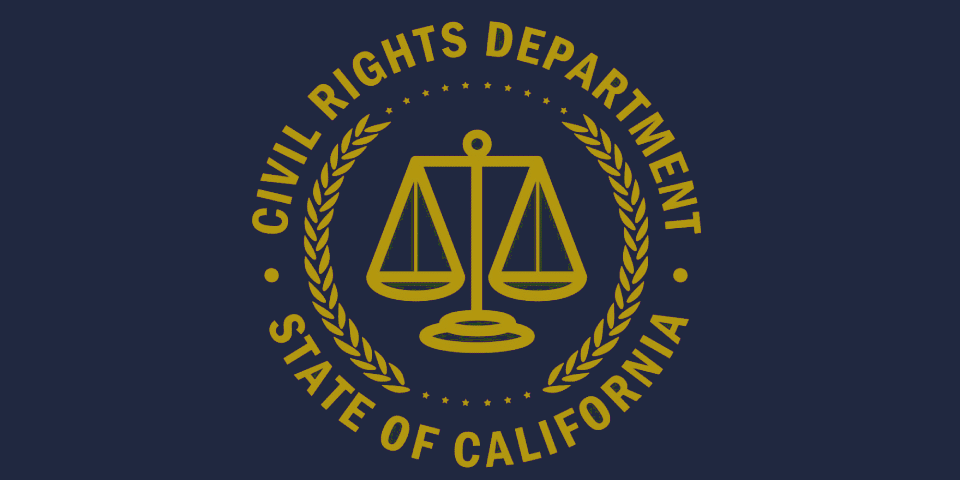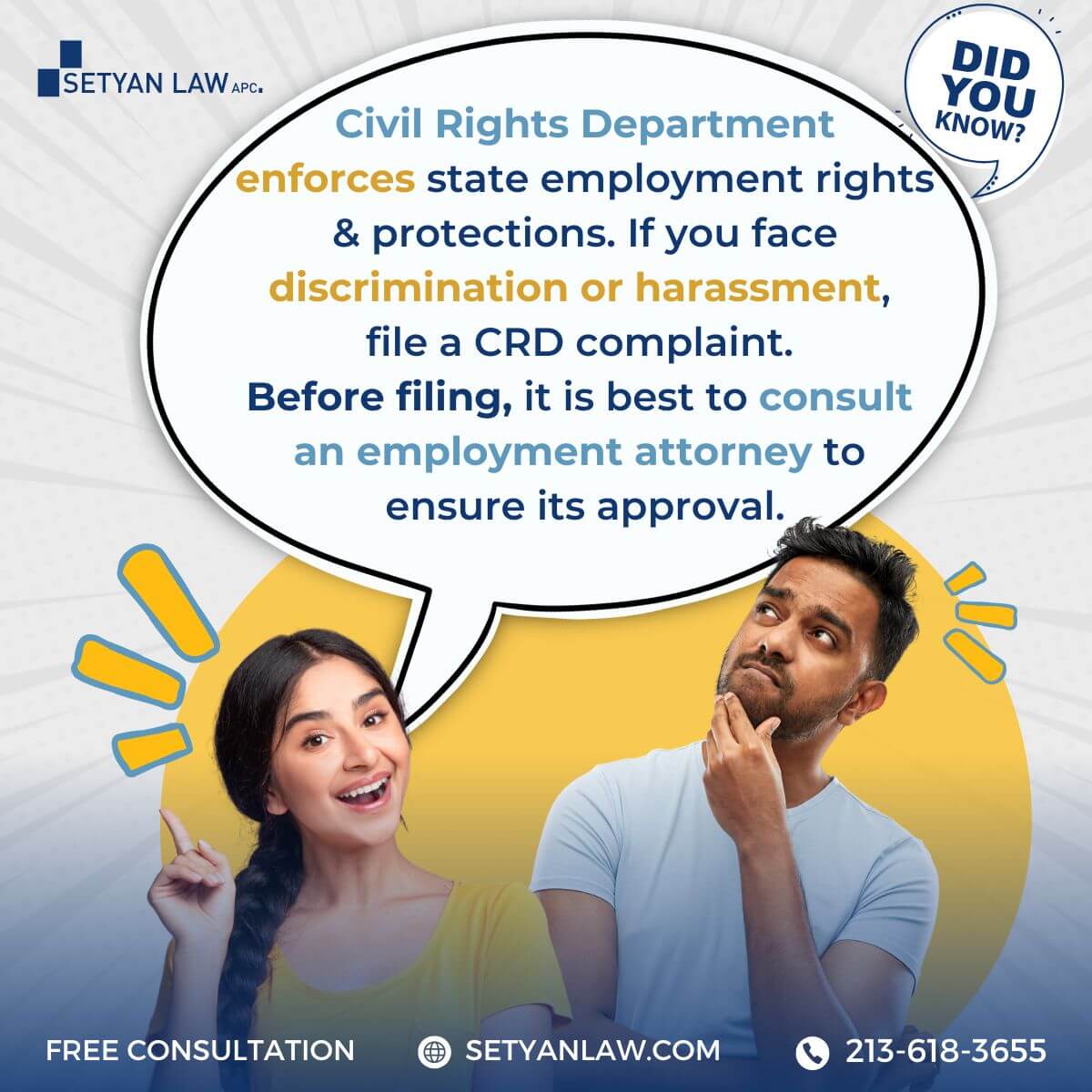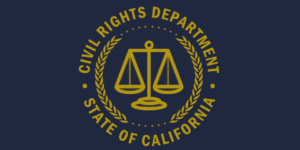Updated October 21, 2025
Filing a California CRD Complaint: A Step-by-Step Guide [2025 Update]
Filing a California Department of Fair Employment and Housing complaint (now called a CRD complaint) can seem overwhelming if you've experienced workplace discrimination or harassment. However, this crucial process protects your rights and holds employers accountable for violating California's robust anti-discrimination laws.
Fortunately, navigating the CRD complaint process doesn't have to be confusing. With proper guidance and preparation, you can effectively assert your rights under California employment law. Whether you're facing racial discrimination, sexual harassment, disability bias, or other workplace violations, understanding how to properly file your complaint is the first step toward justice.
This comprehensive guide walks you through the entire CRD complaint process, from gathering evidence to understanding what happens after you file. We'll explain when to involve an attorney, what documentation strengthens your case, and the important deadlines you must meet to preserve your legal rights.
Despite California having some of the strongest employee protections in the nation, many workers don't know how to navigate the system effectively. This step-by-step guide provides the knowledge you need to protect yourself and seek appropriate remedies when facing workplace discrimination.
Understand What a CRD Complaint Is
A California Civil Rights Department (CRD) complaint represents your formal declaration that your civil rights have been violated in the workplace, housing, or other protected areas. Before 2022, these were known as DFEH complaints, but the department changed its name to better reflect its expanding mission [1].
What the Civil Rights Department (CRD) does
The CRD stands as the largest state civil rights agency in the United States [2], serving as the institutional centerpiece of California's commitment to protecting citizens from discrimination. Established in 1959 as the Fair Employment Practices Commission, this agency evolved over decades to become a comprehensive civil rights enforcement body [3].
The department's primary responsibilities include:
- Investigating thousands of discrimination complaints annually
- Facilitating settlement agreements between parties
- Filing lawsuits in court to protect civil rights
- Providing free conflict resolution services
- Collecting and analyzing workplace pay data to identify disparities
- Operating the California vs. Hate Resource Line and Network
- Conducting education and outreach programs
Additionally, the CRD enforces civil rights laws across multiple domains, including employment, housing, business establishments, state-funded programs, professional relationships, hate violence, and human trafficking [4].
Types of workplace violations covered
A CRD complaint can address several workplace violations under the Fair Employment and Housing Act (FEHA). The most common include:
Discrimination: Unfair treatment based on protected characteristics in hiring, promotion, compensation, or termination decisions.
Harassment: Unwelcome conduct based on protected characteristics that creates a hostile work environment.
Retaliation: Adverse actions against employees who report discrimination, participate in investigations, or oppose prohibited activities [1].
Furthermore, the CRD handles complaints about failure to provide reasonable accommodations for disabilities or medical conditions [5]. For employment cases specifically, complaints must be filed within three years of the last discriminatory act [6].
Key protections under California law
California provides broader protections than federal law, covering employers with as few as five employees [7]. The FEHA prohibits discrimination based on numerous protected characteristics, including:
- Race, color, or national origin
- Gender, gender identity, gender expression
- Sexual orientation
- Religion or religious creed
- Age (40 and over)
- Disability (physical or mental)
- Medical condition or genetic information
- Pregnancy, childbirth, or related conditions
- Marital status
- Military or veteran status [7]
Notably, California's definition of disability is more inclusive than federal law. Under state law, a condition need only "limit" a major life activity rather than "substantially limit" it as required by federal standards [8].
Once the CRD receives a complaint, it evaluates the facts to determine if the case falls under its jurisdiction. The filing of a complaint does not mean the CRD has already determined a violation occurred. Instead, it marks the beginning of an independent investigation to assess whether reasonable cause exists to believe a law was violated [6].
For individuals who believe their rights have been violated, understanding the CRD complaint process represents the crucial first step toward seeking justice and holding violators accountable under California's robust civil rights framework.
Step 1: Talk to a Lawyer First
Before diving into the filing process, consulting with an attorney experienced in employment law is essential for anyone considering a CRD complaint. This critical first step can significantly impact your case's outcome and protect your legal rights.
Why legal advice matters
Consulting with a qualified employment attorney initially offers several distinct advantages:
- Case evaluation: An attorney will assess whether your experience meets the legal standard under the Fair Employment and Housing Act (FEHA) and identify all potential claims [9].
- Strategic guidance: Legal counsel helps draft your complaint to preserve every viable claim while ensuring all jurisdictional requirements and deadlines are met [10].
- Evidence preservation: Lawyers know how to gather and document evidence effectively, strengthening your position [11].
- Protection from common mistakes: Filing without legal advice frequently leads to vague allegations with no legal weight, missed claims, and failure to establish discriminatory motives [10].
Many individuals skip legal consultation thinking they can't afford an attorney. However, most employment lawyers work on contingency basis, meaning you pay nothing upfront and only pay a percentage if they recover money for you [12].
When to request a Right-to-Sue letter
A Right-to-Sue letter from the CRD indicates you can proceed with filing a lawsuit in court. While not inherently good or bad for your case, understanding when to request one is crucial:
- Immediate need: Consider requesting this letter immediately if you already have an attorney and want to bypass the CRD investigation process [13].
- Strategic timing: Your attorney might advise obtaining this letter if litigation offers a better strategy than the CRD investigation [10].
- Critical deadlines: Once you receive a Right-to-Sue letter from the CRD, you typically have one year to file a lawsuit [12].
- Federal considerations: For dual-filed complaints, EEOC Right-to-Sue letters give you just 90 days to file in federal court [14].
Important: The CRD explicitly states it is "advisable only if you have an attorney" to request a Right-to-Sue letter [13]. Missing these deadlines means permanently losing your right to sue, regardless of how strong your case might be [14].
How to find an employment attorney
Locating a qualified employment lawyer is straightforward through several resources:
- California State Bar: Visit www.calbar.ca.gov for legal referral resources [15].
- County Bar Association: Local bar associations maintain referral services for employment attorneys.
- Legal Aid Organizations: These provide reduced-cost or free services for qualifying individuals.
- Initial Consultations: Many attorneys offer free consultations for discrimination cases to evaluate the merits [11].
When selecting an attorney, look for experience specifically with CRD complaints and employment discrimination cases. Ask about their track record with similar cases and their approach to agency representation [11].
Remember that the right attorney should understand the emotional and financial stress discrimination causes. They should provide comprehensive support through every step while protecting your job position as long as possible [11][10].
Essentially, while you aren't legally required to have an attorney to file a CRD complaint, the complexity of employment discrimination cases typically requires experienced legal representation to maximize your chances of success [14][12].
Step 2: Gather Strong Evidence
Building a strong foundation of evidence is critical to the success of your California Civil Rights Department (CRD) complaint. Without compelling documentation, even legitimate discrimination claims may fail to progress through the investigation process.
Documenting incidents and timelines
Creating a detailed chronological record serves as the backbone of your complaint. Start documenting immediately upon noticing potential discrimination:
- Maintain a journal of all relevant incidents with precise dates, times, and locations
- Record names of individuals involved, including potential witnesses
- Note exactly what happened during each incident in objective, factual language
Timing is particularly important in employment cases. Under California law, if an employer takes adverse action within 90 days of your protected activity, there's a presumption that it was retaliatory, shifting the burden to the employer to prove otherwise [1]. Moreover, complaints must be filed within 300 days from notice of the alleged discriminatory act [16].
Collecting emails, texts, and witness statements
Communications often provide the most compelling evidence in discrimination cases. Consequently, preserve all forms of workplace correspondence:
- Digital communications: Save emails, text messages, social media posts, and screenshots related to your situation [1]
- Performance evaluations: Keep copies, especially those showing sudden changes after engaging in protected activity [1]
- Company policies: Retain employee handbooks and written workplace policies [17]
- Pay documentation: Gather pay stubs showing reductions or disparities [7]
Witness testimony substantially strengthens a case. Collect written statements from coworkers who directly observed the discrimination or adverse actions [1]. These accounts carry significant weight since witnesses typically have nothing to gain by supporting your claim.
Proof of protected class status
Establishing your membership in a protected class is fundamental to discrimination claims. Generally, you'll need documentation that demonstrates:
- Medical conditions or disability status through relevant medical records [18]
- Pregnancy-related accommodations or leave requests [5]
- Religious accommodation requests [9]
- Age verification for age discrimination claims
- Documentation related to national origin, gender identity, or other protected characteristics [7]
For retaliation complaints specifically, you must additionally document:
- Evidence of your protected activity (like copies of formal complaints) [1]
- Records showing adverse employment actions (termination notices, demotion paperwork) [1]
- Documentation establishing the connection between your protected activity and subsequent negative treatment [1]
During the formal CRD investigation, you'll have the opportunity to submit a rebuttal to your employer's response. Subsequently, you can provide witness contact information and supporting documents that contradict information presented by your employer [16].
Remember that both direct and circumstantial evidence can prove discrimination. While direct evidence (like explicit discriminatory statements) is ideal but rare, circumstantial evidence showing patterns of unequal treatment is often equally effective in building a compelling case [19].
Step 3: File Your Complaint with the CRD
Once you've gathered evidence and consulted with an attorney, the next crucial step is submitting your formal complaint to the California Civil Rights Department (CRD). The method you choose impacts how quickly your case moves forward.
Filing online vs. by mail
The CRD offers multiple submission options, although online filing provides clear advantages:
Online filing through the California Civil Rights System (CCRS) portal is the fastest and most efficient method. This approach offers several benefits:
- Self-service appointment scheduling and rescheduling
- Ability to upload supporting documentation as needed
- Option to pause and resume your filing within 30 days
- Immediate transmission to CRD staff for review
To file online, first register for a CCRS account using a valid email address. After logging in, select the appropriate intake form that matches your complaint type.
Alternatively, you can submit your complaint via mail by sending a completed intake form to CRD headquarters (651 Bannon Street, Suite 200, Sacramento, CA 95811). Although mail filing remains an option, it typically extends processing time. The CRD also accepts complaints by email, phone (800-884-1684), and in person at office locations.
What information you need to include
For the CRD to properly assess your complaint, prepare to provide:
- Your complete contact information
- Detailed description of the discriminatory incidents, including specific dates
- Names and contact information of all individuals involved in the incidents
- Names and contact information of potential witnesses
- Copies of relevant documents or other supporting evidence
For employment cases, you must submit your intake form within three years of the last discriminatory act. For most other cases, the deadline is one year from the date you were last harmed.
If you cannot immediately gather all required information, you can still begin the filing process through CCRS and add details later. Your unfiled complaint remains available in the system for 30 days.
How to request dual filing with the EEOC
In many cases, workplace discrimination violates both state and federal laws. Therefore, you can request "dual filing" of your complaint—meaning the CRD will automatically share it with the federal Equal Employment Opportunity Commission (EEOC).
When using the online system, simply indicate your preference for dual filing during the submission process. This approach protects your rights under both California and federal anti-discrimination laws without requiring separate filings.
The EEOC and CRD maintain a "worksharing agreement" that streamlines this process. If your complaint is initially filed with one agency and covered by laws enforced by both, it will automatically be shared with the other agency while the original agency typically retains jurisdiction for processing.
Step 4: What Happens After You File
After submitting your CRD complaint, a structured process begins that determines the outcome of your discrimination allegations. Understanding each phase helps set realistic expectations as your case moves forward.
The intake interview process
Upon receiving your intake form, the CRD schedules an interview with a representative who evaluates whether your situation falls under their jurisdiction. This initial assessment determines if a formal complaint can be accepted for investigation [18]. During this conversation, be prepared to provide:
- Specific dates of alleged discrimination
- Names and contact information of witnesses
- Supporting documentation like emails, text messages, or termination letters
- Medical documentation (for disability or pregnancy cases) [18]
CRD investigation and employer response
Following acceptance of your complaint, the CRD prepares a formal complaint document for your signature. Once signed and returned, this document is sent to your employer (now the "respondent"), who typically has 30 days to respond [6]. The investigation process includes:
- Review of evidence from both parties
- Witness interviews and document analysis
- Independent assessment of legal issues [18]
Your employer must conduct an impartial, comprehensive investigation of the allegations, preferably under legal counsel's guidance [6].
Mediation, settlement, or right-to-sue outcomes
The CRD's Dispute Resolution Division (DRD) can accept complaints for mediation at any stage of the process [20]. This free service often results in millions of dollars in direct relief annually to affected Californians [20]. Possible outcomes include:
- Settlement through mediation
- Case closure if no reasonable cause is found
- Reasonable cause determination requiring mandatory mediation
- Issuance of a right-to-sue letter allowing you to pursue a private lawsuit [18][7]
If the CRD determines reasonable cause exists, they may file a lawsuit on your behalf or issue a right-to-sue letter [18][9]. Remember that litigation is typically more expensive and time-consuming than mediation [21].
Conclusion
Filing a CRD complaint represents a powerful tool for California workers facing discrimination or harassment. Throughout this guide, we've outlined the essential steps to protect your rights effectively under California's robust anti-discrimination framework.
First and foremost, consulting with an experienced employment attorney before filing significantly increases your chances of success. These professionals evaluate your case, provide strategic guidance, and help avoid common pitfalls that could derail your complaint.
Additionally, thorough documentation serves as the backbone of any successful CRD complaint. Evidence including detailed incident logs, relevant communications, witness statements, and proof of your protected status builds a compelling case that stands up to scrutiny during investigations.
The filing process itself requires careful attention to deadlines and details. Although online submission through the CCRS portal offers the most efficient path forward, you must include comprehensive information about the alleged discrimination regardless of your chosen filing method. Dual filing with the EEOC further protects your rights under both state and federal law.
After submission, your case enters the CRD's structured review process, potentially leading to investigation, mediation, settlement, or litigation. Each path offers different advantages depending on your specific circumstances.
Remember, California provides some of the nation's strongest employee protections, but these safeguards only work when properly accessed. Therefore, following the steps outlined in this guide ensures you navigate the process correctly while maximizing your chances of resolution.
The decision to file a CRD complaint undoubtedly requires courage. Nevertheless, standing up against workplace discrimination not only addresses your personal situation but also contributes to fairer workplaces across California. With proper preparation and guidance, you can effectively assert your rights and seek the justice you deserve.
References
[1] – https://setyanlaw.com/filing-retaliation-claim-california-civil-rights-department/
[2] – https://setyanlaw.com/california-civil-rights-department-crd/
[3] – https://calcivilrights.ca.gov/aboutcrd/
[4] – https://feherlawfirm.com/california-discrimination-laws/
[5] – https://calcivilrights.ca.gov/employment/
[6] – https://www.karensloatlaw.com/blog/2024/02/how-should-an-employer-in-california-respond-to-a-crd-complaint/
[7] – https://www.shouselaw.com/ca/blog/dfeh-complaint/
[8] – https://auxiliary.fresnostate.edu/association/hr/documents/employee_resources/brochures-time_of_hire/crd-fact-sheets.pdf
[9] – https://setyanlaw.com/crd-complaint-process-california/
[10] – https://www.tong-law.com/file-crd-complaint/
[11] – https://feherlawfirm.com/what-legal-steps-can-i-take-if-im-discriminated-against-at-work/
[12] – https://www.civilrightsca.com/practice-areas/administrative-complaints-eeoc-and-crd/
[13] – https://calcivilrights.ca.gov/obtainrighttosue/
[14] – https://feherlawfirm.com/right-to-sue-letter/
[15] – https://calcivilrights.ca.gov/wp-content/uploads/sites/32/2024/09/CRD-Right-to-Sue_ENG.pdf
[16] – https://ccrd.colorado.gov/the-complaint-process
[17] – https://kevensteinberglaw.com/californias-employment-discrimination-laws-know-your-rights/
[18] – https://calcivilrights.ca.gov/complaintprocess/
[19] – https://www.kingsiegel.com/blog/how-to-prove-workplace-discrimination-in-california/
[20] – https://calcivilrights.ca.gov/disputeresolution/
[21] – https://www.laemploymentlawyer.com/blog/2022/12/should-i-mediate-my-employment-dispute/
Why Choose Setyan Law, APC?
Consulting a wrongful termination attorney will provide you with the necessary guidance and support to navigate the legal process effectively. Remember, time is of the essence, so seek legal advice promptly to maximize your chances of a successful outcome.
Call Setyan Law at (213)-618-3655 for a consultation.






